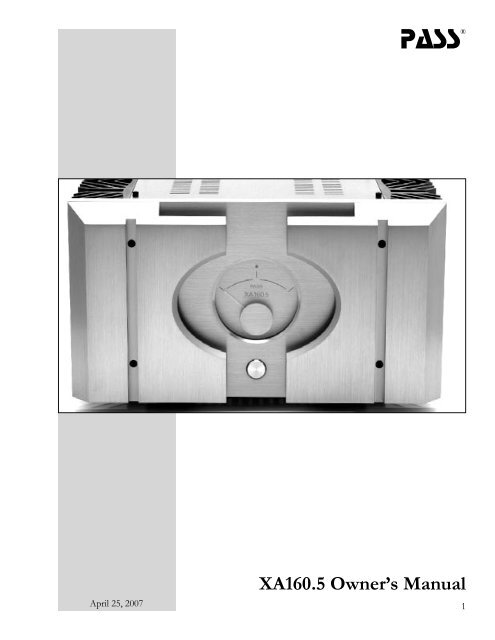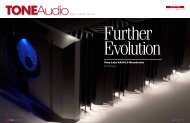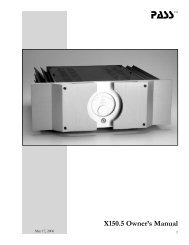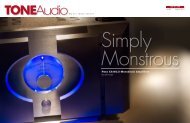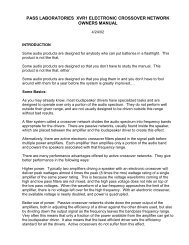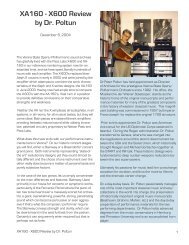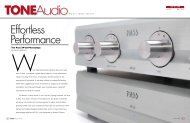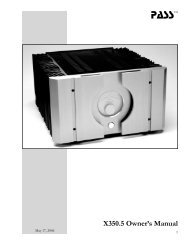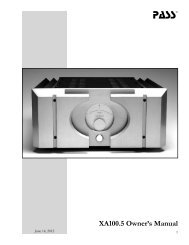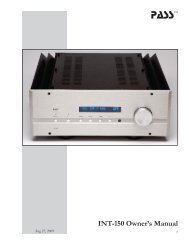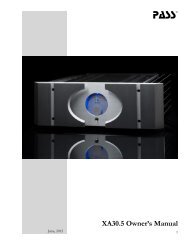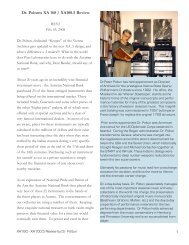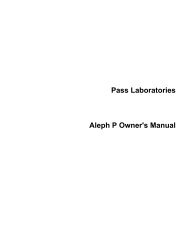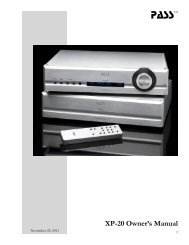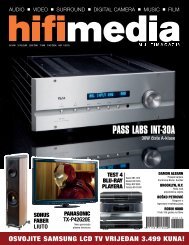Owner's Manual - Pass Labs
Owner's Manual - Pass Labs
Owner's Manual - Pass Labs
You also want an ePaper? Increase the reach of your titles
YUMPU automatically turns print PDFs into web optimized ePapers that Google loves.
pass®XA160.5 April Owner’s 25, 2007<strong>Manual</strong>XA160.5 Owner’s <strong>Manual</strong>1
Nelson <strong>Pass</strong> has been designing audio electronics since about 1971,first with ESS (remember Heil transformers?), and then forming anew company, Threshold in 1975. Threshold pioneered the designof high power Class A power amplifiers and later, high poweramplifiers using only local feedback (the Stasis series).<strong>Pass</strong> sold Threshold and created <strong>Pass</strong> Laboratories in 1991, where heconcentrated first on elevating single-ended Class A power amplifiersto new power levels and performance, the Aleph series.Along the way he found the time to design successful lines ofamplifiers for such companies as Adcom and Nakamichi, and hascontributed approximately 60 designs (so far) to the public “Do-It-Yourself ” hobbyist community.Over the years, Nelson <strong>Pass</strong> has made power, simplicity, andperformance his design signature. The hardware tends to run heavyand hot, but elicits high performance and reliability from simplecircuits with little or no negative feedback..In 1998 <strong>Pass</strong> <strong>Labs</strong> released the X series of audio power amplifiers,based on the “SuperSymmetric” topology (U.S. Patent #5,376,899)which elicits high power and performance from simple circuits withminimal feedback.The first X amplifier, the X1000 was intended as the premierexample of the power of this principle, delivering 1000 watts rmsinto 8 ohms at low distortion. By itself of course, this is no miracle,but you have to consider that products with comparable performancehave complicated circuits with as many as nine consecutive gainstages and lots and lots of negative feedback. The X1000 had onlytwo stages and used only local feedback.The difference was the unique balanced circuit topology in whichcircuit errors are replicated at both output terminals so as to canceland disappear across the loudspeaker terminals. The high quality ofthe sound reflects both the low distortion and simplicity of the gainpath.The SuperSymmetric circuit consists of two identical matchedcircuits arranged like the wings of a butterfly, showing symmetryfrom left to right, and operating balanced to the loudspeaker. Theamplified signal appears with opposing phase across the loudspeaker.Most of the distortion and noise appears in phase across theloudspeaker, and is not seen.XA160.5 Owner’s <strong>Manual</strong>2
We start with simple FET circuits already having low distortion andnoise, and arrange them in two symmetrical halves. The two halvesof the amplifier channel are closely matched, eliminating a largeportion of distortion and noise without feedback. A small amountof feedback is also applied, not so much for the purpose of reducingdistortion but to make the distortion as identical as possible on bothpolarities of the balanced output.It is easier to make distortions more identical than to remove themwith feedback, and this is the operating principle of X amplifiers.Since the X1000, <strong>Pass</strong> <strong>Labs</strong> products have continuously evolvedtoward higher performance. The Class AB “X” series was joinedby the Class A “XA” amplifiers. Subsequent improvements to theClass AB “X” amplifiers resulted in the “X.5” products, and theirphenomenal success has led to the Class A “XA.5” series.As always the goal has been the best musical and objectiveperformance possible with minimal parts in the signal path andminimal feedback. This process is not completely understood, andmany of the improvements are the result of trial and error andextensive listening.Measurement of performance is important to us, and we feel thatwell-designed product sounds good and measures good. Apparentlyit is possible to make an amplifier which measures well but whichdoes not please the ears, and so we let our ears be the final judge.X.5 and XA.5 amplifiers utilize the same basic circuit topologyand gain devices. They differ in the sizes of the power supplies,the chassis and heat sinks, and the number of output devices. Theoutput stages of the X.5 series are operated in heavily biased ClassAB, with an idling dissipation similar to the rated output. The XAamplifiers operate pure Class A with idling dissipation more thantwice the rated output.Within any given chassis size, the X and XA amplifiers are designedto dissipate about the same power, and it is not surprising that thisleads to two channel amplifiers with half the output power perchannel of comparable mono amplifiers, and Class A amplifiers withhalf the output of Class AB amplifiers.The X amplifiers deliver more output power per dollar, and the XAamplifiers have a better subjective performance. All of the amplifiersdrive known loudspeaker loads without misbehaving, and all areunconditionally stable into low impedance and reactive loads.XA160.5 Owner’s <strong>Manual</strong>3
All the usual performance metrics - power, distortion, noise, inputimpedance, damping factor and bandwidth have all been improvedin this latest generation. The power supplies are larger, with fastrectifiers gating to larger capacitor banks. The increases in AC linenoise worldwide have been addressed with heavier EMI filteringand dramatically quieter power transformers. In addition, throughimproved biasing regulation, the circuits give much more consistentperformance under varying AC line voltages and over a variety ofambient temperatures.All this is very nice, but only if it improves your listening experience.We listen very carefully and critically to our amplifiers with a widevariety of associated equipment and we take our time with it.Musical performance is most important, and is the basis of oursuccess over the years.It’s true that we also value the other things. The design andmanufacturing decisions have to balance subjective performanceagainst reliability, cost, specs, and ego (in approximately that order).That is why we make more than one amplifier, but all are built withthe same commitment to quality.If you have purchased this amplifier, we thank you for yourconfidence, and hope that you enjoy it for many years. If you haveany questions or comments, or if we can help you with your audiosystem, pelase don’t hesitate to contact us.service@passlabs.comwww.passlabs.comTel (530) 367 3690Fax (530) 367 2193<strong>Pass</strong> <strong>Labs</strong>,PO Box 21924449 Foresthill Rd,Foresthill CA 95631XA160.5 Owner’s <strong>Manual</strong>4
SET UPX amplifiers run at about the same power as their output rating, andXA amplifier run more than twice that. The heat sinks on the sideof the amplifier run hot to the touch – about 25 to 30 degrees C.above ambient, so you can expect 50 to 55 degrees C. temperatureson the heat sinks. It is very important to the long life of theamplifier that they get good ventilation.You can put this amplifier anywhere you want, but it must have goodventilation. Do not place it in enclosed cabinets or small closetswithout means for air to circulate freely. Stacking these poweramplifiers directly upon each other is not recommended for the samereason. You should have a minimum of about 6 inches clearance tothe top and sides for adequate air circulation.When not actually intending to play music the amplifier should beleft in standby mode, where it draws only a few watts of bias onthe output stage. If you wish to reduce the power draw to 0, youcan shut the amplifier off via the rear panel switch, however werecommend that for minimum noise this switch should be toggled instand-by mode.We have provided a standard IEC power cord that fits into thestandard 15 amp IEC receptacle at the rear of the amplifier chassis.With the exception of the largest of the X and XA series, there is nodifficulty running two amplifiers on a single 15-amp circuit. Giventhe high current draw, we generally do not recommend active lineconditioners, although they are unlikely to damage the amplifier.This amplifier is equipped for operation with an earth groundprovided by the users AC outlet. Never defeat this groundconnection. The signal ground of this amplifier is connected toearth through a power thermistor, which provides a safety groundbut provides isolation from system ground loops.For maximum safety we suggest that the power cord should be thelast cable installed on your power-amplifier. You may, if you wish,substitute a 15-amp aftermarket power cord for the one we havesupplied. Only use power cords, which meet all local safety standardsand carry acceptance marks from the local regulatory authority. Thepower cord should be attached to the amplifier prior to plugginginto house power. Place the rear mounted switch in the off (down)position before plugging in this amplifier.XA160.5 Owner’s <strong>Manual</strong>5
The amplifier’s voltage and current rating are indicated on therear panel. It will be either 240 volts, 230 volts, 220 volts, 120volts or 100 volts. The larger amplifiers have a circuit breaker ofthe appropriate capacity. The smaller power amplifiers use a slowblow3AG type fuse. The frequency rating of the AC line sourceis 50 to 60 Hz. Please verify that the amplifiers indicated voltagerequirements are consistent with the supplied voltage and current atyour location.On the rear panel you will find both RCA and XLR type inputconnections for single-ended or balanced inputs. If you use the RCAinput, be certain that the XLR connector has a gold shorting plugbetween pins 1 and 3, which connects the “minus” input to ground,otherwise the amplifier will not operate properly. If you lose thisplug, just contact the factory – we give them away all the time.The question comes up all the time – are balanced inputs (XLR)better than single-ended (RCA)? The answer is that balanced linesgenerally give lower noise and slightly less distortion. They arerecommended unless your favorite source component has only RCAoutputs.Also on the rear panel are the output connections for theloudspeakers. On stereo amplifiers there is one pair per channel, andon mono amplifiers we provide two pairs wired in parallel to facilitate“bi-wiring” a loudspeaker. As you are probably familiar, the red oneis positive polarity, and the black one is negative.Please note that, being a balanced output, both of these terminalsare electrically live – neither is grounded and should not be treatedas ground. This is particularly important if you are using theoutput of the amp to also drive a subwoofer amplifier or otheractive component. If there is any question, please contact themanufacturers of the products involved – both they and we will behappy to advise you.If you happen to need a clean signal ground connection for anyreason, we provide a dedicated 5 way binding post just for that onthe rear of the amplifier.On the rear panel you will also find a pair of 5 way binding postsfor external turn-on control. Applying 5 to 12 volts DC at thisconnection will override the front panel stand-by switch and turn theamplifier on.XA160.5 Owner’s <strong>Manual</strong>6
So the amplifier is sitting there unconnected.Make sure that the rear panel power switch/breaker is off (down).Plug the AC cord into the back of the amplifier, and then into thewall. Then turn the power switch/breaker on (up). The lights inyour house will dim for a moment as the power supply charges thecapacitors.If your amplifier uses a circuit breaker and not a fuse, please notethat this circuit breaker is not a “safety device” or “emergencydisconnect” for this product. It will provide current limiting whichwill protect the amplifier, but it does not provide personal shockprotection in the manner of a ground-fault interrupter. One morereason why it is important not to defeat the Earth connection ofyour power cord.On the front panel, the “Standby” LED indicator should be glowingblue, indicating that AC power is available and the capacitor banksare charged. If the “Power” LEDs are lighting the meter, use thefront panel stand-by button to go to stand-by mode.Now turn off the rear power switch and unplug the AC power cordfrom the wall while you connect the speakers and inputs.Check to make certain that the loudspeaker cables aren’t shorted atthe loudspeaker end, connect speaker cables to the output bindingposts on the amplifiers, observing correct polarity. The outputbinding posts will accept either bare wire or spades. (Regulatoryagencies in many countries have banned binding posts that willaccept a banana plug, forcing us to abandon this option.) Make surethat your speaker wires only attach to the outputs of the amplifier,not to each other and never to the amplifier case.Remember the warning about treating the output connections asground, particularly if you are using a powered subwoofer with thisamplifier. If you need a ground, use the one provided specifically onthe rear panel of the amplifier.The amplifier may be driven single-end or balanced, your choice.Single-ended input will always occur through the RCA connector andbalanced input will always occur through the XLR connector.Again, if you drive the amplifier single-ended then leave the suppliedjumpers in place between pins 1 & 3 on the input XLR.On the XLR connector pin 1 is ground, pin two is positive input andXA160.5 Owner’s <strong>Manual</strong>7
pin 3 is inverted (negative) input. Pin numbers are marked on theXLR. If you re-install the jumper incorrectly or leave it lying about,the amplifier will not work properly, and you will be able to tell.Choose either XLR or RCA inputs. If you run both at once fromdifferent components, the sound is not likely to be optimal, but itshouldn’t cause damage anywhere.Now that the source component is connected, turn the volume allthe way down. Plug the power cord back into the wall, and turn onthe rear power switch.Push the front panel button to activate the amplifier. The lights willcome on.You are ready to play musicWith any luck, you can now enter that blissful state, and we won’texpect you back for a while.It’s always possible that something may go wrong. If so, don’t getexcited. We know It’s really aggravating when a product doesn’twork, but it will get fixed, and often it’s something really simple.We go to a lot of trouble to make products reliable, and the failurerate of our amplifiers is very low. This is small comfort to the few,but take it easy and give us a call if you have problems.People are interested in how long it takes for these amplifiers tobreak in. Depending on the resolution of the rest of your audiochain, you may or may not notice any break in of the amplifierbeyond the first few hours of operation. You will very likely noticethe difference in sonic character between cold and normal operatingtemperature over the first hour, so we recommend letting theseamplifiers warm up before any serious listening.This generation of amplifiers warms up faster and is more bias-stableduring warm up than previous versions, but we still recommend anhour for critical listening. At the factory we adjust the bias and offsetvalues initially and then after warm-up and then again after 48 hours,If necessary. The “sweet spot” is a sink temperature between 50 and55 degrees C., but this is not critical, and will vary with your roomtemperature. You should be able to put your hands on the heat sinkswithout undue discomfort for 5 seconds or so.The amplifier has a thermal cutout that will disconnect AC power ifXA160.5 Owner’s <strong>Manual</strong>8
the temperature exceeds 75 degrees Centigrade. This thermal cutoutshould never occur in real life. This is a very rare occurrence, andwould indicate a serious problem.Interconnects and Speaker CablesWe have a general recommendation about interconnects, andspeaker cables: They should cost less than the amplifier, and containat least some conductive material. We have tried a lot of productsand most work well, but as a practical matter we cannot make blanketrecommendations.The amplifier is not sensitive to source interconnects. It is also notsensitive to radio frequency pickup, which allows some flexibility inchoosing source interconnects without shields, though shields areusually a very good idea. For long runs balanced cables are highlyrecommended for their inherent rejection of noise.We prefer speaker cables that are short and stout. Oxygen-freecopper and silver are the suggested materials. If you find any reallyexceptional cable made of gold, please gift us a couple hundred feet.Fortunately this amplifier is not sensitive to the capacitive/inductivecharacter of some of the specialty speaker cables, so feel free toexperiment.We have found that about 90 per cent of bad sounding cables arereally bad sounding connections, and we recommend that attentionbe paid to cleanliness of electrical contact surfaces and properconnector fit.Speaker cables should be firmly tightened down at the speakeroutput terminals, but not with a wrench. Output terminals will notwithstand the levels of torque that may be easily applied by wrench.Hand tightening without excessive force is plenty. Cleaning contactsurfaces with one of the commercially available electronic contactcleaners should be part of your annual system maintenance.Product LifeSo how long will this hardware last? It is our experience that, barringabuse or the odd failure of a component, the first things to go will bethe power supply capacitors, and from experience, they will last 15 to30 years. Fortunately they die gracefully and are easily replaced by agood technician.XA160.5 Owner’s <strong>Manual</strong>9
After that, the longevity will depend upon the number of operatingthermal cycles, but we can say that we have had amplifiers operatingin the field in excess of 20 years with no particular mortality, and wedon’t have good information beyond that.More to the point, you should not worry about it. This is aconservatively built industrial design, not a frail tube circuit run onthe brink of catastrophic failure. If it breaks, we will simply get itfixed, so sleep well.<strong>Pass</strong> LaboratoriesPO Box 21924449 Foresthill RdForesthill, CA 95631 USAwww.passlabs.comsales@passlabs.comservice@passlabas.comtel: (530) 367 3690fax: (530) 367 2193“pass”, “<strong>Pass</strong>”, “<strong>Pass</strong> <strong>Labs</strong>”, “<strong>Pass</strong> Laboratories”,“Supersymmetery”, “Aleph”, and “Zen” and are all registeredtrademarks of <strong>Pass</strong> Laboratories, Inc., and all rights thereto areprotected by law.XA160.5 Owner’s <strong>Manual</strong>10
XA160.5 Owner’s <strong>Manual</strong>11
Warranty InformationAll <strong>Pass</strong> Laboratories products purchased new from an authorized<strong>Pass</strong> Laboratories dealer in North America are covered by atransferable, limited 3-year warranty.This warranty includes parts and labor charges incurred at the repairfacility. Consequential damages are specifically not covered anddamage due to modification or physical abuse is also not covered.The customer assumes responsibility for shipping and insurance toand from the factory, or a factory specified repair facility.Non-North American customers should consult with their original<strong>Pass</strong> <strong>Labs</strong> dealer or distributor for warranty repair instruction priorto contacting the factory or shipping product for repair. Non-North American product must be returned to the country of originfor warranty service. Foreign distributors are only required tooffer warranty service on <strong>Pass</strong> Laboratories product that they haveimported.Conditions of warranty service and customer rights for productpurchased outside the United States may vary depending upon thedistributor and local laws. Please check with your local distributorfor specific information.Any modifications to <strong>Pass</strong> Laboratories products that have notreceived written factory approval nullify all claims and void thewarranty. Should a modified product be returned to the factory forrepair the owner will be required to pay all necessary charges for therepair in addition to those charges required to return the product toits original configuration.In the case of safety issues, no product shall be returned to thecustomer without those safety issues being corrected to the mostrecent accepted standards.Removal or alteration of original <strong>Pass</strong> <strong>Labs</strong> serial numbers voids thefactory warranty. Product with altered or missing serial numberswill be suspected as counterfeit product. <strong>Pass</strong> Laboratories will notrepair or in any way indemnify any counterfeit or cloned product.<strong>Pass</strong> Laboratories does not offer products in voltages intended forinternational markets either to authorized <strong>Pass</strong> <strong>Labs</strong> dealers or tothird parties located in the United States or Canada.XA160.5 Owner’s <strong>Manual</strong>12
For your protection pleaseread the following:Water and moisture: Electrical devices should not be used nearwater ( as per example, near a bathtub, washbasin, kitchen sink,laundry tub, wet basement or swimming pool ). Care should betaken such that objects do not have the opportunity to fall, and thatliquid is never spilled onto or into the device enclosure throughopenings.Power Sources: An electrical device must be connected to a mainspower source in strict accordance with the supplied product owner’smanual. Please verify that the AC mains voltage specified in theproduct manual matches those requirements indicated on the unitand the AC voltage provided to your location by the power company.Grounding: Adequate precautions should be taken so that thegrounding provisions built into an electrical product are neverdefeated.Power Cords: <strong>Pass</strong> Laboratories provides a power supply cord thatmeets all legislated requirements for the market in which the productwas originally sold. If you choose to substitute an after-marketproduct we urge you to choose one that is fully safety rated by thenecessary local authority.Power Cord Protection: Power supply cords should be routed sothat they are not likely to be walked on, abraded, or pinched by itemsplaced on or against them, paying particular attention to cords wherethey enter plugs or exit from a device. Never under any circumstanceinsert a cut or damaged power cord into a mains power socket.Power and Signal: Cables should never be connected /disconnected with equipment powered up. Failure to heed thiswarning may damage or destroy equipment.Ventilation: Power-amplifiers run hot, but you should be able toplace your hands on them without discomfort. You must allow forthis heat in installation, by providing for free air circulation aroundthe product. Electronics should not be subjected to sources ofexcessive radiant heat. Excessive heat can shorten the life of theproduct and may cause the electronics to self-protect and shut down.Servicing: To reduce the risk of fire, electrical shock or otherinjuries, the user should not attempt to service the device beyondthat which is described in the operating instructions. All otherservicing must be referred to qualified service personnel.XA160.5 Owner’s <strong>Manual</strong>13


